|
Additional Lessons |
 About These
Lessons About These
Lessons
The following classroom lessons are great for students
who want additional listening and reading practice. |
-
Travel America -
Beginner
Level. Do you love America and American
English? Learn before you travel. Facts and other
cool stuff about your favorite U.S. state. Great
English reading practice.
|
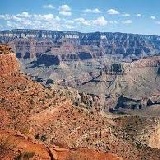 Travel
America - Nevada Travel
America - Nevada
(Beginner -
Reading)
Learn some interesting facts and read interesting
stories about Nevada. |
 Nevada Nevada
Nevada's name comes from the Spanish word meaning
"snow clad"--a reference to the snow-covered peaks
of the Sierra Nevada. The discovery of the Comstock
Lode, a massive deposit of silver, in 1859 brought
many fortune seekers. Statehood followed shortly
afterwards in 1864, when Nevada was admitted as the
36th state. Nevada is in a mountain region that
includes semiarid grasslands and sandy deserts, and
is the most arid (dry) state in the nation. Like
oases in the desert, Nevada's two main cities--Las
Vegas and Reno--attract fortune seekers from around
the world hoping to strike it rich in the many
casinos located there. The capital is Carson City,
and the state flower is the sagebrush. |
Nevada
State Flag
Nevada has had four state flags during its history.
The first flag was adopted in 1905 (over 40 years after
Nevada became a state in 1864). The current flag of Nevada
was was approved in 1991.
Nevada's flag has a cobalt blue background. A five-pointed
silver star (silver is the state metal) is positioned in the
upper left quarter of the flag between two sprays of
sagebrush that cross to form a half-wreath (sagebrush is
Nevada's state flower, and one of Nevada's nicknames is "The
Sagebrush State").
Across the top of the wreath is a golden scroll with the
words "Battle Born" in black letters. The phrase "Battle
Born" signifies that Nevada entered the Union during the
Civil War. Below the star, in golden letters, is the name
"Nevada." |
|
Source:
State Symbols USA |
|
|
 Nevada
State Facts Nevada
State Facts
Picture: state seal of Nevada |
|
State Capital |
Carson City |
|
Nickname |
The Silver State / Sagebrush State / Battle Born
State |
|
Motto |
All for our country |
|
Statehood |
October 31, 1864 (36th) |
|
Origin of Name |
From the Spanish "Sierra Nevada," or "snow-covered
mountain range" |
|
Largest Cities |
Las Vegas, Reno, Henderson, North Las Vegas, Sparks |
|
Border States |
Arizona, California, Idaho, Oregon, Utah |
|
Area |
109,806 sq. mi., 7th largest |
|
State Bird |
Mountain Bluebird |
|
State Flower |
Sagebrush (artemisia tridentata) |
|
State Tree |
Single Leaf Piñon and Bristlecone Pine (pinus
monophylla / pinus aristata) |
|
State Song |
Home Means Nevada |
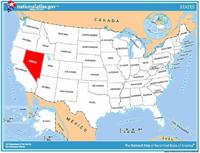 Travel and tourism site for Nevada - This state
travel and territorial tourism site provides ideas for your
vacations, meetings, and more. Travel and tourism site for Nevada - This state
travel and territorial tourism site provides ideas for your
vacations, meetings, and more. |
|
|
Nevada Stories |
|
|
Annual Native American Arts Festival
Can you balance a jar on your head that is filled with water, like
the woman in the photo is doing? (Don't try this indoors or with
something breakable!) The woman in the photo is in Native dress. At
one time, women carried water on their head so their hands could be
free to carry other things as they gathered food for their families.
Each spring, Henderson's Clark County Heritage Museum in Nevada
hosts the annual Native American Arts Festival. This three-day
festival highlights traditional crafts, foods, arts and culture.
The dancing performances are very popular. Native American dancing
often involves singing and the wearing of elaborate clothing
decorated with feathers, beads, fringes, and sometimes bells. Men
and women usually dance separately, even if they are in groups.
There are different contests to see who can present themselves in
the most authentic manner, and performers spend much time working on
their outfits. Many of the artisans show how to make local Native
crafts such as pottery, sand paintings, baskets or cloth. Each year,
thousands of people come to the festival. Its location near Las
Vegas makes it easy to reach for many visitors. The museum itself is
an interesting place. You can see different kinds of minerals at a
mining exhibit, look at a 1918 railroad steam engine, or even visit
a re-created ghost town! |
|
|
Nevada's Buckaroos
What's a buckaroo?
The Great Basin, which includes the region of northern Nevada, is
wide-open territory primarily known as cattle country. Amid the
desert and mountains is the Humboldt River, which begins in the
mountain ranges and ends in the desert. This is the home of the
buckaroos, cowboys who work on cattle ranches in Nevada. They get
their name from vaquero, (pronounced bah-care-oh) the Spanish word
for "cowboy," because the first buckaroos in the area were
Spanish-speaking horsemen.
Buckaroos have developed many different special skills to work with
the land and cattle. They run cattle drives, rope and brand cows,
and shoe horses. They are most famous for breaking (making suitable
for riding) horses, also known as "starting colts." But buckaroos
also bail hay, mend fences, and haul trucks out of desert mud holes.
They work long hours for low wages, but buckaroos are rugged
independent people who choose to work close to nature. |
|
|
Re-Discover Nevada 2000
If you think of Nevada only as the state where the city of Las Vegas
is located, you'd be ignoring its long and interesting history.
Originally, many Native American tribes occupied the area that is
now Nevada. Ancient Native American culture goes back at least
10,000 years, and still today, the state is home to more than a
dozen tribes.
In 1855, a group of Mormon missionaries were the first non-natives
to settle in the Las Vegas Valley. They built an adobe fort, which
is now a museum. The area appealed to them because of the valley
located along the Old Spanish Trail. In fact, Las Vegas means "the
meadows" in Spanish.
In addition to the Mormons, pioneers moving westward sometimes
settled in the area, and the Pony Express riders cut through
hundreds of miles of what is now Nevada to deliver mail. After the
discovery of large gold and silver deposits in 1859, more people
arrived in the hopes of striking it rich. In the early 1900s, Las
Vegas became a railroad town and then in the 1930s the town grew
further when gambling was legalized.
Nevada is an attractive place to live for a lot of people. It grew
by a whopping 66 percent from 1990 to 2000 -- the fastest of any
state. |
|
Source:
Library of Congress |
|
 National
Forests, Parks, and Monuments of Nevada National
Forests, Parks, and Monuments of Nevada
The following is a description of national
forests, parks, and monuments in the state
of Nevada. If you plan to visit or live in
Nevada for awhile then you should definitely
plan to visit some of these fantastic
places. |
|
|
|
National Forests |
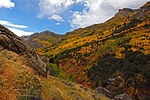 Humboldt-Toiyabe Humboldt-Toiyabe
As the largest National Forest outside of
Alaska, Humboldt-Toiyabe occupies many of
the mountains of Nevada's Basin and Range
Province. Spring Mountains National
Recreation Area is located near Las Vegas
and is part of the forest. This national
forest is also partially located in the
state of California. |
 Inyo Inyo
Located in the Sierra Nevada, Inyo includes
Mono Lake, bristlecone pines, the Long
Valley Caldera, nine wilderness areas, and
Mount Whitney, which at 14,505 ft (4,421 m)
is the highest point in the United States
outside of Alaska. This national forest is
also partially located in the state of
California. |
 Lake
Tahoe Basin Management Unit Lake
Tahoe Basin Management Unit
The Forest Service lands surrounding Lake
Tahoe are managed by the Lake Tahoe Basin
Management Unit, which was created in April
1973 in order to protect the lake's unique
ecological and recreational values. This
management unit is also partially located in
the state of California. |
|
|
|
National Parks |
 Great
Basin Great
Basin
Based around Nevada's second tallest
mountain, Wheeler Peak, Great Basin National
Park contains 5,000-year-old bristlecone
pines, a rock glacier, and the limestone
Lehman Caves. Due to its remote location,
the park has some of the country's darkest
night skies. Wildlife includes the
Townsend's big-eared bat, pronghorn, and
Bonneville cutthroat trout. |
|
|
|
National Monuments |
 Basin
and Range Basin
and Range
Remote, undeveloped mountains and valleys in
Lincoln and Nye counties in southeastern
Nevada. |
 Gold
Butte Gold
Butte
Mojave Desert landscape of dramatic red
sandstone, canyons, forested mountains,
ancient rock art, rock shelters, roasting
pits, and a mining ghost town. |
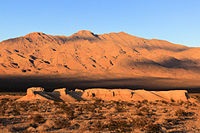 Tule
Springs Fossil Beds Tule
Springs Fossil Beds
A major archaeological site north of Las
Vegas where thousands of prehistoric
fossils, including mammoth, lion, and camel
in an area that was once a wetland. |
|
|
Travel America |
|
|
Great Basin National Park
(Beginner - Listening,
reading)
A video lesson which shows you an interesting place in America.
The English is
spoken at 75% of normal speed.
Great English listening and reading practice.
This video is all about Great Basin National Park. |
|
 Travel
America Travel
America
Do you love America and American English? Learn before
you travel. Facts and other cool stuff about your
favorite U.S. state. Visit the Fun Easy English Travel
America pages. Read about the beautiful National
Forests, Parks, and Monuments. Great English reading practice. |
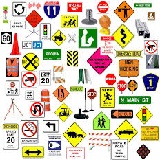 Drive America Drive America
Planning to drive in America? Learn the rules and
regulations. Great English reading practice. |
|